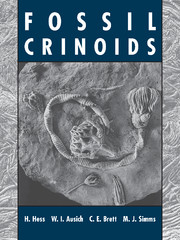Book contents
- Frontmatter
- Contents
- List of Contributors
- Acknowledgements
- Prelude
- Introduction
- GENERAL PART
- ASSEMBLAGES
- 6 Middle Ordovician Trenton Group of New York, USA
- 7 Middle Ordovician of the Lake Simcoe Area of Ontario, Canada
- 8 Upper Ordovician of the Cincinnati, Ohio, Area, USA
- 9 Silurian of Gotland, Sweden
- 10 Middle Silurian Rochester Shale of Western New York, USA, and Southern Ontario, Canada
- 11 Scyphocrinitids from the Silurian–Devonian Boundary of Morocco
- 12 Lower Devonian Manlius/Coeymans Formation of Central New York, USA
- 13 Lower Devonian Hunsrück Slate of Germany
- 14 Middle Devonian Windom Shale of Vincent, New York, USA
- 15 Middle Devonian Arkona Shale of Ontario, Canada, and Silica Shale of Ohio, USA
- 16 Lower Mississippian Hampton Formation at LeGrand, Iowa, USA
- 17 Lower Mississippian Burlington Limestone along the Mississippi River Valley in Iowa, Illinois, and Missouri, USA
- 18 Lower Mississippian Edwardsville Formation at Crawfordsville, Indiana, USA
- 19 Upper Pennsylvanian LaSalle Member, Bond Formation of Central Illinois, USA
- 20 Permian
- 21 Triassic Muschelkalk of Central Europe
- 22 Pentacrinites from the Lower Jurassic of the Dorset Coast of Southern England
- 23 Lower Jurassic Posidonia Shale of Southern Germany
- 24 Middle Jurassic of Southern England
- 25 Middle Jurassic of Northern Switzerland
- 26 Upper Jurassic Solnhofen Plattenkalk of Bavaria, Germany
- 27 Uintacrinus Beds of the Upper Cretaceous Niobrara Formation, Kansas, USA
- 28 Tertiary
- 29 Recent
- Appendix I Geological Time Table with Crinoid Assemblages
- Appendix II Glossary of Rocks
- Bibliography
- General Index
- Taxonomic Index
11 - Scyphocrinitids from the Silurian–Devonian Boundary of Morocco
Published online by Cambridge University Press: 10 November 2010
- Frontmatter
- Contents
- List of Contributors
- Acknowledgements
- Prelude
- Introduction
- GENERAL PART
- ASSEMBLAGES
- 6 Middle Ordovician Trenton Group of New York, USA
- 7 Middle Ordovician of the Lake Simcoe Area of Ontario, Canada
- 8 Upper Ordovician of the Cincinnati, Ohio, Area, USA
- 9 Silurian of Gotland, Sweden
- 10 Middle Silurian Rochester Shale of Western New York, USA, and Southern Ontario, Canada
- 11 Scyphocrinitids from the Silurian–Devonian Boundary of Morocco
- 12 Lower Devonian Manlius/Coeymans Formation of Central New York, USA
- 13 Lower Devonian Hunsrück Slate of Germany
- 14 Middle Devonian Windom Shale of Vincent, New York, USA
- 15 Middle Devonian Arkona Shale of Ontario, Canada, and Silica Shale of Ohio, USA
- 16 Lower Mississippian Hampton Formation at LeGrand, Iowa, USA
- 17 Lower Mississippian Burlington Limestone along the Mississippi River Valley in Iowa, Illinois, and Missouri, USA
- 18 Lower Mississippian Edwardsville Formation at Crawfordsville, Indiana, USA
- 19 Upper Pennsylvanian LaSalle Member, Bond Formation of Central Illinois, USA
- 20 Permian
- 21 Triassic Muschelkalk of Central Europe
- 22 Pentacrinites from the Lower Jurassic of the Dorset Coast of Southern England
- 23 Lower Jurassic Posidonia Shale of Southern Germany
- 24 Middle Jurassic of Southern England
- 25 Middle Jurassic of Northern Switzerland
- 26 Upper Jurassic Solnhofen Plattenkalk of Bavaria, Germany
- 27 Uintacrinus Beds of the Upper Cretaceous Niobrara Formation, Kansas, USA
- 28 Tertiary
- 29 Recent
- Appendix I Geological Time Table with Crinoid Assemblages
- Appendix II Glossary of Rocks
- Bibliography
- General Index
- Taxonomic Index
Summary
SEA LILIES IN THE DESERT
Slabs with beautifully preserved scyphocrinitids from the Sahara region regularly appear at mineral and fossil fairs; most of these fossils are labelled, ‘Erfoud’. Very little work has been undertaken on the detailed stratigraphy of the scyphocrinitid beds of Morocco; hence, the information provided in this chapter is limited. One would hope that future work will increase our knowledge of these remarkable occurrences.
The western Sahara (Fig. 108) underwent several marine transgressions during the Palaeozoic. The extended Silurian transgression started during mid-Llandovery times with the deposition of graptolitic shales. Subsidence increased, so that the thickest part of the succession accumulated during Ludlow times. At the southern edge of the Anti-Atlas in the Dra Plain, in the Tafilalt area near Erfoud and in the Ougarta chains of western Algeria, the Silurian is composed largely of black, sometimes bituminous shales with graptolites. These shales weather on the surface to brighter colours. In the Pridolian part of the series (uppermost Silurian, about 410 million years before present) they contain bands of blue, fossiliferous limestones with Scyphocrinites, orthocone nautiloids (‘Orthoceras’), bivalves (Cardiola) and gastropods. Upper Silurian to Lower Devonian argillaceous shales or laminated clays with limestone intercalations or lenses containing scyphocrinitids and orthocone nautiloids are in fact found in a wide area, from the coast near Casablanca and Rabat, across the High Atlas, to the Dra Plain, the Tafilalt, and the Ougarta chains of western Algeria. The limestones commonly occur as nodular concretions in large cushion-like masses that are interbedded in the shales.
- Type
- Chapter
- Information
- Fossil Crinoids , pp. 93 - 102Publisher: Cambridge University PressPrint publication year: 1999
- 4
- Cited by

